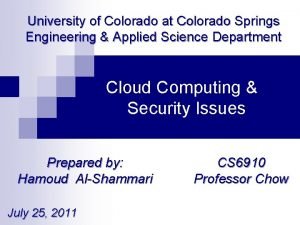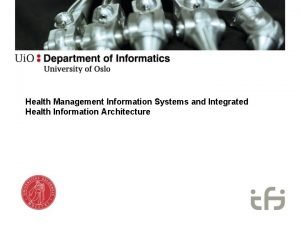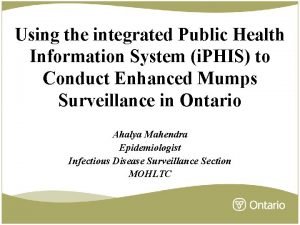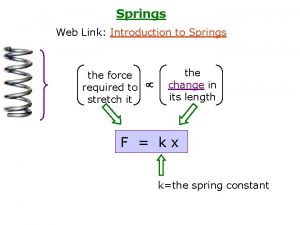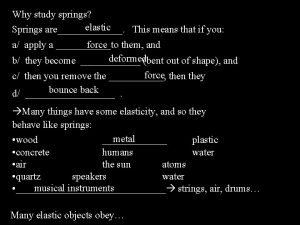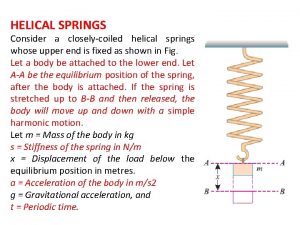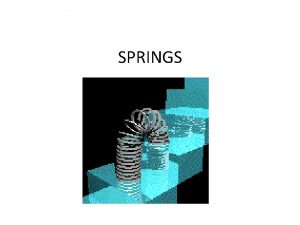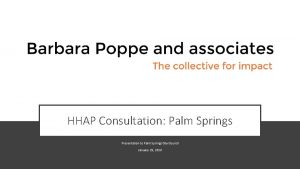Colorado Springs Introduction to Integrated System Health Engineering

















- Slides: 17

Colorado Springs Introduction to Integrated System Health Engineering and Management in Aerospace Dr. Stephen B. Johnson NASA Marshall Space Flight Center sjohns 22@uccs. edu ISHEM Forum, 8 Nov 05: Page 1

Outline of Talk • Definitions • Operational & Design Theory • Principles ISHEM Forum, 8 Nov 05: Page 2

Integrated System Health Engineering & Management • ISHEM = the processes, techniques, and technologies used to design, analyze, build, verify, and operate a system to prevent faults and/or mitigate their effects • Technical, individual, and social aspects • Synonym: Dependable System Design and Operations • “Dependability” ISHEM Forum, 8 Nov 05: Page 3

Complexity • Beyond the capability of any one person to understand or keep track of all details – Heterogeneous (power, propulsion, etc. ) – Deep: requires many years of study to master – Scale: the system requires so many components that it is impossible for any one person to keep all in mind – Interactivity: interactions between internal components, and with the external environment are “messy” ISHEM Forum, 8 Nov 05: Page 4

Implication of Complexity • By definition, beyond what any one person can master (our cognitive abilities are limited) • REQUIRES communication among individuals • Implication: – Engineering of a “complex” system requires excellent communication and social skills ISHEM Forum, 8 Nov 05: Page 5

Failure • “A loss of intended function or performance of an unintended function. ” – Can be designer’s or user’s intent • Failure is both individually and socially defined – “in the eye of the beholder” – Some “failures” are considered normal by others ISHEM Forum, 8 Nov 05: Page 6

Faults and Errors • Fault: The physical or logical cause of an anomaly. – The “root cause”, can be at various levels – Might or might not lead to “failure” • Anomaly (error): A detectable undesired state. – The “detector” must ultimately interpret the “state” as “undesirable” – Can be user, designer, others ISHEM Forum, 8 Nov 05: Page 7

Causes of Faults and Failures • Individual performance failure (cognitive) – Lack of knowledge (unaware of data) – Misinterpreted data – Simple mistakes (transposition, sign error, poor solder, etc. , usually from human inattention) • Social performance failure (communicative) – Miscommunication (misinterpretation) – Failure to communicate: information exists, but never got to the person or people who needed it ISHEM Forum, 8 Nov 05: Page 8

Embedded Knowledge • Technologies are nothing more than “embedded knowledge” • Technologies embody (incarnate) the knowledge of their creators • “Faults” result from flaws in the knowledge of the creators, OR mismatch in understanding between creators and users – Cognitive or Communicative! ISHEM Forum, 8 Nov 05: Page 9

ISHEM Functional Relationships • Circular, “closed-loop” relationships • Hints at the physical architecture ISHEM Forum, 8 Nov 05: Page 10

ISHEM Operational Architecture ISHEM Forum, 8 Nov 05: Page 11

Typical Functions, Mechanisms, and Characteristic Times Function Physical Mechanism Characteristic Time Electrical Power Electron transport 1 -10 milliseconds Attitude Control Thruster impulse or reaction wheel acceleration 50 -500 milliseconds Spacecraft Thermal Control Radiative Heat Transfer Minutes to hours Human autonomic response Biochemically-induced electrical signals 500 milliseconds – 1 second Human decision-making Verbal and visual signals between humans, and brain physiology Minutes to days Data computation Electron transport and processor cycle times 10 -100 milliseconds Planetary probe radio data transfer Electromagnetic waves Seconds to hours ISHEM Forum, 8 Nov 05: Page 12

ISHEM in the System Life Cycle ISHEM Forum, 8 Nov 05: Page 13

Principle of Knowledge Redundancy, and Limits • Checking for failure or faults requires a separate, independent, credible knowledge source • Commonality means that reviewers share common assumptions with the reviewed • Independence means reviewers share nothing in common with the reviewed • Complete independence neither possible nor desirable ISHEM Forum, 8 Nov 05: Page 14

Clean Interfaces • Desired and sometimes required • Reduce the “interactivity” between components • Reduce the interactivity of the people and organizations designing and operating the components • Simplifies communication, reduces chance for miscommunication! ISHEM Forum, 8 Nov 05: Page 15

Bureaucracy and “Situational Awareness” • Bureaucracy needed to institute and repeat processes for dependability • Bureaucratization: repetition and suppression or forgetting of reasons behind the rules leads to inattention or misunderstanding, and hence to faults • Must foster individual “awareness” within the bureaucracy… create bureaucracy to fight the deadening effect of bureaucracy! ISHEM Forum, 8 Nov 05: Page 16

Conclusion • NASA has a “culture problem” that leads to occasional failures • The problem is social and cognitive as well as technical • ISHEM to be the overarching theory over the technical, social, and cognitive aspects of preventing & mitigating failure • We are working to install / instill ISHEM into the new Vision for Space Exploration ISHEM Forum, 8 Nov 05: Page 17
 Mt st francis colorado springs
Mt st francis colorado springs Colorado springs school districts
Colorado springs school districts Brandon monson colorado springs
Brandon monson colorado springs Aaron choate colorado springs
Aaron choate colorado springs Audrey field
Audrey field Cloud computing colorado springs
Cloud computing colorado springs Recycled asphalt colorado springs
Recycled asphalt colorado springs Norwood development colorado springs
Norwood development colorado springs Rio grande
Rio grande Integrated engineering management system
Integrated engineering management system Indian health service ehr
Indian health service ehr Jaka to roślina
Jaka to roślina Integrated public health information system
Integrated public health information system Saltless water system dripping springs
Saltless water system dripping springs Colorado physicians health program
Colorado physicians health program Bright health centura
Bright health centura Colorado health op
Colorado health op Cohie
Cohie





